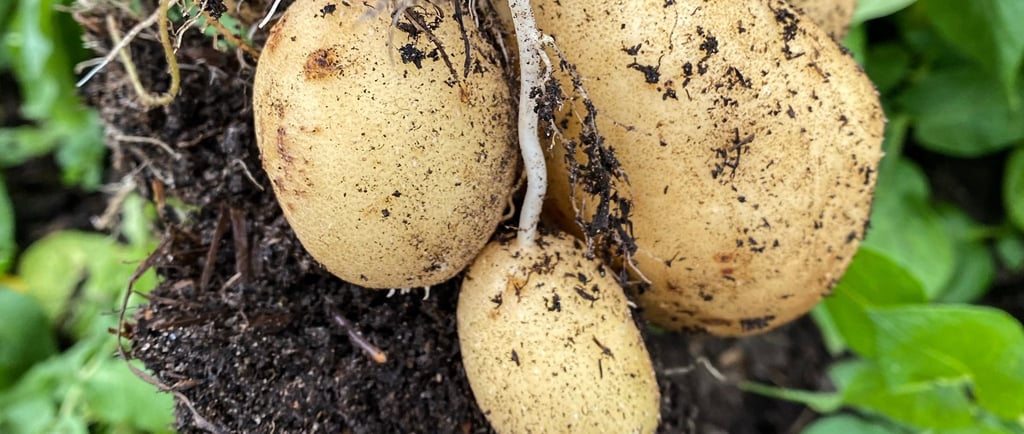FREE POSTAGE & PACKING ON UK ORDERS £20 AND OVER
DEFRA LICENSED - 100% HEIRLOOM, OPEN-POLLINATED l SMALL BATCH, HIGH QUALITY SEEDS

Grow Your Own Potatoes
All you need to know about growing your own potatoes.
2/10/20243 min read


ALL YOU NEED TO KNOW ABOUT GROWING POTATOES
Are you interested in growing potatoes? Whether you're a seasoned gardener or a beginner, potatoes are a versatile and rewarding crop to grow. In this blog, we'll discuss when to start chitting potatoes and where to grow them for the best results.
What is Chitting?
Before we dive into the timing, let's first understand what chitting means. Chitting is the process of encouraging potatoes to sprout before planting them in the ground. By exposing the tubers to light and warmth, you promote the growth of short, sturdy shoots. This can help accelerate the growth process once the potatoes are planted.
When to Start Chitting Potatoes
The timing for chitting potatoes depends on the variety you're growing. Potatoes can be categorized into three main types: first earlies, second earlies, and maincrop.
First Earlies (New Potatoes)
First earlies are the earliest potatoes to be harvested, usually in as little as 10-12 weeks after planting. The plants take up less space, so are useful in smaller plots, and can be grown in containers. As they’re harvested by midsummer, they free up space to grow another crop, such as courgettes or beans, for the rest of the summer
To get a head start, you should start chitting first earlies from late January in mild weather areas up until early March in colder places. Place the tubers in a cool, bright spot with temperatures around 10-15°C (50-59°F). Egg cartons are ideal for keeping the tubers upright.
Second Earlies (New Potatoes)
Second earlies are harvested a few weeks after first earlies. For chitting second earlies, you can follow the same timeline as first earlies. The process is exactly the same.
Maincrop
Produce a larger harvest and bigger individual potatoes, ideal for roasting and baking, and can be stored for use in winter. Maincrop potatoes take the longest to mature and are usually harvested in late summer or early autumn. To chit maincrop potatoes, you should start the process in early spring, around March or April, however there's no real advantage to chitting, given their longer growing season.
Where to Grow Potatoes
Potatoes are a hugely versatile crop that can be grown in various locations. Here are a few key considerations when choosing where to grow your potatoes:
Sunlight
Potatoes thrive in full sun, so choose a spot in your garden that receives at least six to eight hours of direct sunlight per day. This will ensure optimal growth and yield.
Soil
Potatoes prefer well-draining soil that is rich in organic matter. Avoid heavy clay soils that can become waterlogged. If your soil is heavy, consider adding compost or well-rotted manure to improve its texture and fertility.
Space
Ensure that you have enough space for your potato plants to grow. Potatoes can be grown in the ground, raised beds, or even containers. If you're short on space, you can try growing potatoes in bags or pots on a patio or balcony.
Earlies - plant 30cm (1ft) apart, in rows 60cm (2ft) apart
Maincrop - plant 37cm (15in) apart, in rows 75cm (30in) apart
No-Dig Potatoes
With this method of gardening, you can shallow plant the seed potatoes, then add a deep layer of organic matter on top. Once the foliage appears add more organic matter, to 'earth up'. The crop is then super easy to harvest by simply pulling the potatoes out of the mulch.
Rotation
When planning your potato patch, it's important to practice crop rotation. Avoid planting potatoes in the same spot year after year, as this can increase the risk of disease and pests. Rotate your potato crop with other vegetables to maintain soil health.
Now that you know when to start chitting potatoes and where to grow them, you're ready to embark on your potato-growing journey. Enjoy the process of nurturing your plants and look forward to a bountiful harvest!
